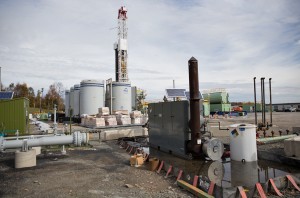Study finds U.S. underestimates climate-damaging methane emissions
-
Marie Cusick
The federal government may be way off when it comes to estimating how much methane is released into the atmosphere, according to a new study. The potent greenhouse gas is second only to carbon dioxide in terms of its significance for global climate change.
The study questions whether the federal Environmental Protection Agency was right to downgrade its estimates of methane emissions related to oil and gas development earlier this year.
“These results cast doubt on the US EPA’s recent decision to downscale its estimates of national natural gas emissions by 25 to 30 percent,” the authors write.
The researchers say government calculations may underestimate true methane emissions by 50 percent. Methane is the main component of natural gas.
The peer reviewed paper from Harvard University and the Carnegie Institution was published today in the journal Proceedings of the National Academy of Sciences. The study was funded through federal research grants and money from the Environmental Defense Fund. The researchers used thousands of observations from aircraft and ground towers to estimate atmospheric methane emissions between 2007 and 2008– before much of the recent shale gas boom began.
There is an ongoing debate among scientists over the role of natural gas in reducing climate change. Although gas is much cleaner than oil and coal when it’s burned, methane leaks throughout the production and distribution process.
The question is just how much methane is leaking. It is much more potent than carbon dioxide as a heat-trapping greenhouse gas but remains in the atmosphere for a shorter period of time.
Cornell professor Robert Howarth, whose work on methane sparked a fierce debate over the role of natural gas and climate change, says he’s pleased to see other scientists analyzing direct measurements of methane.
“This new study shows the methane emissions should be at least twice as high as what the EPA is saying,” he says. “That’s a big difference.”
Howarth’s 2011 paper did not rely on direct measurements. He was criticized by the oil and gas industry and his assumptions were also challenged by other scientists.
Another recent paper from the University of Texas, which was one of the first study’s to rely on direct measurements, found methane emissions during the well completion phase (the process of getting a well ready for production) were much lower than projected, while gas leaks from valves and other equipment on well pads were higher.
Other scientists say more direct measurements are needed to assess the scope of the leakage rates. Earlier this year, the EPA’s own internal watchdog issued a report saying the agency needs to get better data to track emissions from the oil and gas industry.
The Marcellus Shale Coalition– a trade group representing Pennsylvania’s gas industry– says they welcome the new research, but pointed out the data comes from 2007 and 2008.
“Since then, shale producers have leveraged green completion technologies across our operations,” says MSC spokesman Steve Forde in a statement.
Green completion technology, which limits emissions, is not currently required. The EPA will require it in a rule that will go into effect in 2015.

















